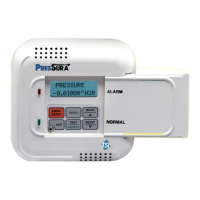Example: The LOW ALARM set point is -0.00072 “H
2
O. The HIGH ALARM set point cannot be set lower than
-0.00128 “H
2
O.
3. Second sensor alarms can be programmed for positive or negative pressure. Both the second sensor low and high
alarms must be programmed either positive or negative. The second sensor alarms ignore rule 1 above.
4. Alarms do not terminate until pressure exceeds the alarm set point. The set point must be slightly exceeded before alarm
will terminate.
5. The ALARM RESET item selects how the alarms will terminate when monitor returns to the safe range. The pressure and
flow alarms all terminate the same; they are either latched or unlatched. If unlatched is selected the alarms automatically
turn off when the value slightly exceeds the alarm set point. If latched is selected the alarms will not terminate until the
pressure exceeds the alarm set point and the RESET key is pressed.
6. There is a programmable ALARM DELAY that determines how long to delay before activating the alarms. This delay
affects all alarms, pressure and flow.
7. The MUTE TIMEOUT item temporarily turns the audible alarm off for all pressure and flow alarms.
8. The display can only show one alarm message. Therefore, the monitor has an alarm priority system, with the highest
priority alarm being displayed. If multiple alarms exist, the lower priority alarms will not display until after the highest
priority alarm has been eliminated. The alarm priority is as follows:
Pressure sensor - low alarm
Pressure sensor - high alarm
Flow station - minimum exhaust flow
Flow station - minimum supply flow
Second pressure sensor - low alarm
Second pressure sensor - high alarm
Data error
9. The low and high alarms are absolute values. The chart below shows how the values must be programmed in order to
operate correctly.
-0.2 inches H
2
O 0 +0.2 inches H
2
O
(maximum negative) (maximum positive)
High Low Zero Low High
Negative Negative Positive Positive
Alarm Alarm Alarm Alarm
The value of each alarm is unimportant (except for small dead band) in graph above. It is important to understand that the
negative (positive) low alarm must be between zero (0) pressure and the high alarm value.

